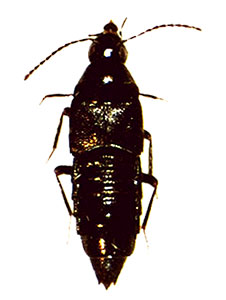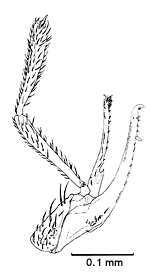Gymnusa
James S. Ashe (1947-2005) and Stylianos Chatzimanolis


This tree diagram shows the relationships between several groups of organisms.
The root of the current tree connects the organisms featured in this tree to their containing group and the rest of the Tree of Life. The basal branching point in the tree represents the ancestor of the other groups in the tree. This ancestor diversified over time into several descendent subgroups, which are represented as internal nodes and terminal taxa to the right.

You can click on the root to travel down the Tree of Life all the way to the root of all Life, and you can click on the names of descendent subgroups to travel up the Tree of Life all the way to individual species.
For more information on ToL tree formatting, please see Interpreting the Tree or Classification. To learn more about phylogenetic trees, please visit our Phylogenetic Biology pages.
close boxIntroduction
Adults of the 10 described species of Gymnusa are mostly black (a few are reddish brown to dark brown) and range in length from 4.2-6.5 millimeters. They live in moss and detritus in swamps, bogs and in the marshy edges of lakes, streams and slowly moving rivers.
Gymnusa are known from northern Nearctic and Palearctic regions.
Klimaszewski (1979, 1982) revised the species of Gymnusa and provides species descriptions, keys for identification, illustrations of diagnostic characteristics, information about distribution and habitat, and a phylogenetic analysis.
Characteristics
Adults of Gymnusa are easily distinguished from their possible sister group Stylogymnusa by the presence in Gymnusa of:
- transverse labrum (about 2 times as wide as long);
- 1 large subapical tooth on inner edge of mandible;
- labial palpus present, 3-articled;
- inconspicuous basal segment of maxillary palpus;
- outer posterior margin of elytra emarginate;
- pectinate margins of abdominal segments III-V with teeth of only one type (teeth with rounded apices)
(Klimaszewski 1979)
Ashe (2000) also provides detailed discussion of the structure of Gymnusa, and illustrations of mouthparts, within the context of a comparison with Stylogymnusa.
Discussion of Phylogenetic Relationships
Klimaszewski (1979) provided the only available phylogenetic analysis for the species of Gymnusa based on morphological features of adults.
References
Ashe, J. S. 2000. Mouthpart structure of Stylogymnusa subantartica Hammond, 1975 (Coleoptera: Staphylinidae: Aleocharinae) with a reanalysis of the phylogenetic position of the genus. Zoological journal of the Linnean Society 130: 471-498.
Klimaszewski, J. 1979. A revision of the Gymnusini and Deinopsini of the World. Canada Agriculture monograph No. 25. 169 pp.
Klimaszeski, J. 1982. A revision of the Gymnusini and Deinopsini of the world. Sup. 2. Canadian Entomologist 114: 317-335.
Title Illustrations

| Scientific Name | Gymnusa pseudovariagata |
|---|---|
| Location | Canada (B. C.) |
| Size | length 5.8 mm |
| Copyright |
© 1997 James S. Ashe (1947-2005)

|
About This Page
Development of this page made possible by National Science Foundation PEET grants DEB 95-21755 and DEB 99-78110 to James S. Ashe.
All images on this page copyright © 1997-2003 James S. Ashe.
James S. Ashe (1947-2005)

University of Kansas, Lawrence, Kansas, USA
Stylianos Chatzimanolis

University of Tennessee at Chattanooga
Page copyright © 1997 James S. Ashe (1947-2005) and Stylianos Chatzimanolis
All Rights Reserved.
- First online 29 August 1997
- Content changed 06 November 2003
Citing this page:
Ashe (1947-2005), James S. and Stylianos Chatzimanolis. 2003. Gymnusa. Version 06 November 2003. http://tolweb.org/Gymnusa/10098/2003.11.06 in The Tree of Life Web Project, http://tolweb.org/














 Go to quick links
Go to quick search
Go to navigation for this section of the ToL site
Go to detailed links for the ToL site
Go to quick links
Go to quick search
Go to navigation for this section of the ToL site
Go to detailed links for the ToL site